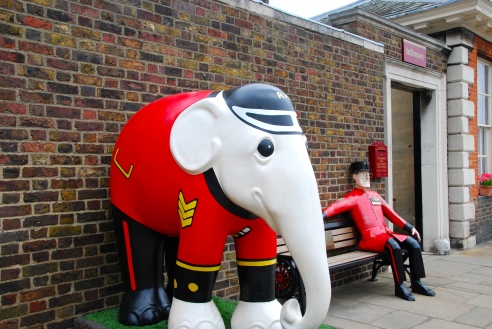Chatting to the Chelsea Pensioners

Killing time sometimes leads to wonderful discoveries while travelling. On a stopover in London earlier this year, I had allowed myself extra time to find an unfamiliar place and arrived too early for my appointment. I was in the Royal Borough of Kensington and Chelsea – in Chelsea, to be precise – and decided to walk down to the Thames for a look at the river.
As I walked past the Royal Hospital Chelsea, I was greeted cheerily by two of the scarlet-coated Chelsea Pensioners. England has many wonderful traditions and this is one of them. Having lived in London for several years – many years ago – I knew about the Chelsea Pensioners but only in a passing way. On this day, I was able to find out more.
Parts of the Royal Hospital Chelsea are open to the public, so after chatting to the two gentlemen who were at the gates, I headed in for a look. The Chelsea Pensioners live in this imposing building, designed by Sir Christopher Wren for King Charles II more than 300 years ago. The King, aware that there was a growing number of soldiers who were no longer fit for active service, decided to create a place that would be “home” for those who had served their country.
Founded in 1682 “for the succour and relief of veterans broken by age and war”, this is not a hospital in the normal sense of the word. Instead it is more a retirement home, caring for elderly and infirm “ordinary” veteran soldiers to whom their nation owes a debt of gratitude. Today the Royal Hospital Chelsea is home to about 300 Chelsea Pensioners, who have the right to live there until they die, knowing they will never be alone. It also has nursing facilities for those who need it. One of the most interesting areas of the small museum is a mock-up of the “berths” or bedrooms of the pensioners, which in the late 1990s were remodelled to the current 9 feet square. The wooden frame of the berth is the original Wren design but mod cons such as power and TV points and wardrobes have been added.
While most of the Chelsea Pensioners are men, former servicewomen have also been admitted since 2009. Anyone who is over 65 and has served as a regular soldier, who has no dependent spouse or family, who finds themselves in need and who is “of good character” can apply to become a Chelsea Pensioner and wear the distinctive uniform. Former officers must have served at least 12 years in the ranks before receiving a commission.
I learned that the Royal Hospital Chelsea is not owned by the British government, nor by the army. It is an independent charity and runs largely on donations. It also runs tours (yes, a Chelsea Pensioner will be your guide) that last about 90 minutes and cost about 10 pounds. You must have a group of four or more for those, and I didn’t have time or a group, so just went in as an individual for a look at the museum, gift shop and grounds. You can also check out the chapel and the Great Hall, which is still used daily as the main dining room for the residents.
 So if you happen to be in Chelsea, pop in and find out more about the story behind this wonderful institution.
So if you happen to be in Chelsea, pop in and find out more about the story behind this wonderful institution.



6 Responses to “Chatting to the Chelsea Pensioners”
I have a soft spot for Chelsea, it was where I lived while doing the Aussie rite of passage to London.
Ah, yes…I lived in West Kensington when I was rite-of-passaging (we called it OE for Overseas Experience), and then later on in Notting Hill. I love going back to London, so much has changed but so much stays the same it always seems familiar. More to come…
Very interesting topic!
Thank you! Glad you enjoyed reading it.
You were so smart to strike up a conversation. It’s always so interesting to learn about people or subcultures that you didn’t know about. That’s what I love a bout travel. It’s a chance to learn how much I have yet to learn. “You don’t know what you don’t know.”
Talking to strangers – especially older people – is one of the joys of travel, I think. And when there’s no language barrier, it’s even easier to learn what you want to know! You are so right!